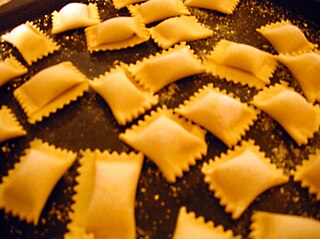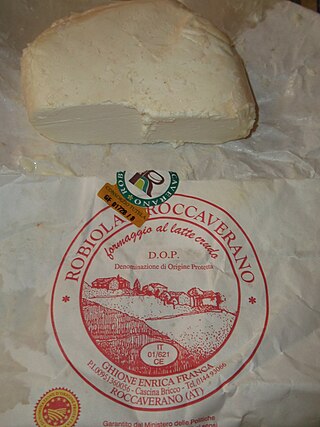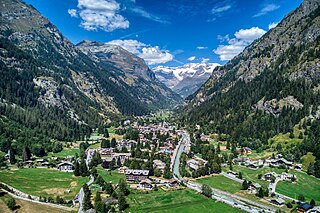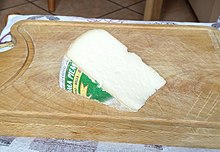
Piedmont is a region of Northwest Italy, one of the 20 regions of Italy. It borders the Liguria region to the south, the Lombardy and Emilia-Romagna regions to the east, and the Aosta Valley region to the northwest; it also borders Switzerland to the north and France to the west. It has an area of 25,402 km2 (9,808 sq mi) making it the second largest region of Italy after Sicily; as of 31 January 2021, the population was 4,269,714. The capital of Piedmont is Turin, which was also the capital of the Kingdom of Italy from 1861 to 1865.

Tomme de Savoie is an upland variety of Tomme cheese, specifically, one from Savoy in the French Alps. It is a mild, semi-firm cow's milk cheese with a beige interior and a thick brownish-grey rind. Tomme de Savoie dates back to ancient history.

Tomme, occasionally spelled Tome, is a class of cheeses produced mainly in the French Alps and in Switzerland. It can be made from cow's, ewe's, or goat's milk. Tommes are normally produced from the skimmed milk left over after the cream has been removed to produce butter and richer cheeses, or when there is too little milk to produce a full cheese. As a result, they are generally low in fat. However, Tomme de Boudane and Tomme de Revard can contain as much as 20–40% fat. Tomme cheeses date back to ancient history.

The Aosta Valley is a mountainous autonomous region in northwestern Italy. It is bordered by Auvergne-Rhône-Alpes, France, to the west, Valais, Switzerland, to the north, and by Piedmont, Italy, to the south and east. The regional capital is Aosta.

Mascarpone is a soft Italian acid-set cream cheese. It is recognized in Italy as a prodotto agroalimentare tradizionale.

Monte Rosa is a mountain massif in the eastern part of the Pennine Alps, on the border between Italy and Switzerland (Valais). The highest peak of the massif, amongst several peaks of over 4.000 m, is the Dufourspitze, the second highest mountain in the Alps and western Europe, after Mont Blanc. The east face of the Monte Rosa towards Italy has a height of about 2.400 meters and is the highest mountain wall of the Alps.

Agnolotti is a type of pasta typical of the Piedmont region of Italy, made with small pieces of flattened dough folded over a filling of roasted meat or vegetables. Agnolotti is the plural form of the Italian word "agnolotto". According to a legend, the origin of the name may come from a cook called Angiolino, or "Angelot", an individual from Montferrat who is said to be the inventor of the recipe. Agnolotti can be di magro or di grasso depending on their filling of vegetables or meat.

Aligot is a dish made from cheese blended into mashed potatoes that is made in L'Aubrac region in the southern Massif Central of France. This fondue-like dish from the Aveyron department is a common sight in Auvergne restaurants.

Italian cuisine is a Mediterranean cuisine consisting of the ingredients, recipes and cooking techniques developed in Italy since Roman times and later spread around the world together with waves of Italian diaspora. Some of these foods were imported from other cultures. Significant changes occurred with the colonization of the Americas and the introduction of potatoes, tomatoes, capsicums, maize and sugar beet—the latter introduced in quantity in the 18th century. It is one of the best-known and most appreciated gastronomies worldwide.

Robiola is an Italian soft-ripened cheese of the Stracchino family. It is from the Langhe region and made with varying proportions of cow's, goat's, and sheep's milk. One theory is that the cheese gets its name from the town of Robbio in the province of Pavia; another that the name comes from the word rubeole (ruddy) because of the color of the seasoned rind.

Gressoney-La-Trinité is a town or commune and renowned alpine resort at the foot of Monte Rosa in the Val de Gressoney, which is part of the Aosta Valley region of Northwest Italy. It features one of the most scenic alpine ski resorts in the Aosta Valley.

Gressoney-Saint-Jean is a town and comune in the Aosta Valley region of north-western Italy.

Riva Valdobbia is a fraction in the Province of Vercelli in the Italian region Piedmont, located about 90 kilometres (56 mi) north of Turin and about 70 kilometres (43 mi) northwest of Vercelli. It's an Italian town of 265 inhabitants located in the upper Valsesia, in the province of Vercelli, in Piedmont.

Caprino is an Italian cheese traditionally made from whole or skimmed goat's milk. The name of the cheese derives from the Italian word for goat, capra. With modern methods of production, the cheese is made from cow's milk as well or a combination of both cow's and goat's milks. The two major styles of caprino are fresco ("fresh") and stagionato ("aged").
Tuma or Toma is a stage in the production of Pecorino cheese, which comes before salting and maturation. By extension, it also indicates cheese that is consumed or commercialized at this stage of production.

The Valdostana Pezzata Rossa is an Italian breed of cattle from Valle d'Aosta region in north-western Italy. It is red-pied, usually with white legs, stomach and face. It is one of three regional breeds in the area, the others being the Valdostana Castana and the Valdostana Pezzata Nera. Like them, it derives from inter-breeding of various local breeds and types of cattle. The most important of these were Swiss Simmental cattle, which came into the Valle d'Aosta over the Great St. Bernard Pass. The Valdostana Pezzata Rossa is a dual-purpose breed, raised mainly for milk, but also for meat. Management is normally transhumant: the cattle are stabled only in winter, and spend the summer months on the mountain pastures of the Alps.















